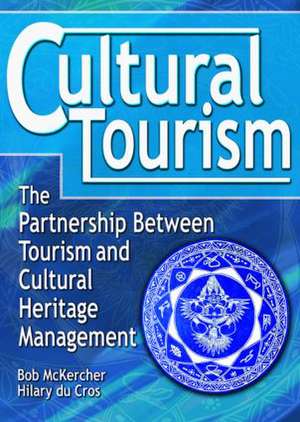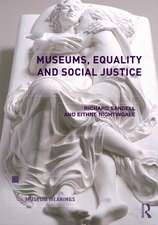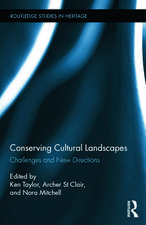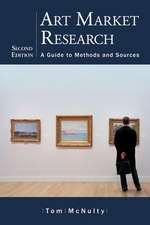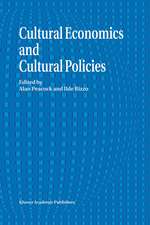Cultural Tourism: The Partnership Between Tourism and Cultural Heritage Management
Autor bob Mckercher, hilary du crosen Limba Engleză Paperback – 7 feb 2002
Unique in concept and content, Cultural Tourism: The Partnership Between Tourism and Cultural Heritage Management examines the relationship between the sectors that represent opposite sides of the cultural tourism coin. While tourism professionals assess cultural assets for their profit potential, cultural heritage professionals judge the same assets for their intrinsic value. Sustainable cultural tourism can only occur when the two sides form a true partnership based on understanding and appreciation of each other's merits. The authors--one, a tourism specialist, the other, a cultural heritage management expert--present a model for a working partnership with mutual benefits, integrating management theory and practice from both disciplines.
Cultural Tourism is the first book to combine the different perspectives of tourism management and cultural heritage management. It examines the role of tangible (physical evidence of culture) and intangible (continuing cultural practices, knowledge, and living experiences) heritage, describes the differences between cultural tourism products and cultural heritage assets, and develops a number of conceptual models, including a classification system for cultural tourists, indicators of tourism potential at cultural and heritage assets, and assessment criteria for cultural and heritage assets with tourism potential.
Cultural Tourism examines the five main constituent elements involved in cultural tourism:
- cultural and heritage assets in tourism sites such as the Royal Palace in Bangkok, the Cook Islands, and Alcatraz Prison in San Francisco.
- tourism--what it is, how it works, and what makes it a success
- five different types of cultural tourists
- consumption of products, value adding, and commodification
- integrating the first four elements to satisfy the tourist, meet the needs of the tourism industry, and conserve the intrinsic value of the asset
Now translated into simplified Chinese.
| Toate formatele și edițiile | Preț | Express |
|---|---|---|
| Paperback (1) | 368.59 lei 43-57 zile | |
| Taylor & Francis – 7 feb 2002 | 368.59 lei 43-57 zile | |
| Hardback (1) | 1042.98 lei 43-57 zile | |
| Taylor & Francis – 13 mar 2002 | 1042.98 lei 43-57 zile |
Preț: 368.59 lei
Preț vechi: 476.27 lei
-23% Nou
70.53€ • 73.84$ • 58.36£
Carte tipărită la comandă
Livrare economică 07-21 aprilie
Specificații
ISBN-10: 0789011069
Pagini: 280
Dimensiuni: 148 x 210 x 15 mm
Greutate: 0.36 kg
Ediția:New.
Editura: Taylor & Francis
Colecția Routledge
Locul publicării:Oxford, United Kingdom
Cuprins
Contents
- Preface
- Acknowledgments
- Chapter 1. Introduction
- Defining Cultural Tourism
- Conceptualizing Cultural Tourism--A Thematic Approach
- The Key Issue: Linking Cultural Heritage Management and Tourism Management
- Chapter 2. Challenges in Achieving Sustainable Cultural Tourism
- Introduction
- Culture and Tourism--Collaborators or Competitors?
- The Independent Evolution of Tourism and Cultural Heritage
- Seven Possible Relationships Between Tourism and Cultural Heritage Management
- The Consequences
- The Solution?
- Chapter 3. How Tourism Works
- Introduction
- The Nature of Tourism
- Attractions Drive Tourism
- Factors Influencing Visitation Levels
- Tourist Behavior
- Cultural Tourism
- Conclusion
- Chapter 4. Cultural Heritage Management
- Introduction
- Core Concepts
- Cultural Heritage Management and Tourism
- Negative and Positive Impacts of Tourism
- Conclusion
- Chapter 5. Tangible Heritage
- Introduction
- Process-Driven Conservation of Tangible Cultural Heritage
- The Scope of Tangible Heritage Assets
- Cultural Significance of Heritage Assets
- Authenticity
- Tourism, Authenticity, and Commodification
- Visitor Accessibility to Tangible Heritage Assets
- Consultation As an Important Element of the Management Process
- Chapter 6. Intangible Heritage and Its Management
- Introduction
- Recognition of Intangible Cultural Heritage Management
- Intangible Heritage Assets--Management and Tourism Issues
- Authenticity and Cultural Space
- Tourism and Changes to Intangible Heritage
- Culturally Appropriate and Sustainable Use of Assets
- Stakeholder Consultation in Setting Management Priorities
- Chapter 7. Cultural Tourism Products--A Regional Perspective
- Introduction
- Products
- Benefits of Adopting a Marketing Approach to Product Development
- Hierarchy of Attractions
- Developing Cultural Tourism Attractions
- Conclusions
- Chapter 8. Commodification, Environmental Bubbles, and Cultural Tourism Products
- Introduction
- Consumption--Strangeness versus Familiarity and the Environmental Bubble
- Creating Cultural Tourism Products or Attractions
- Tactics
- Conclusions
- Chapter 9. The Cultural Tourism Market: A Cultural Tourism Typology
- Introduction
- Who Are Cultural Tourists?
- A Typology of Cultural Tourists: Recognizing Different Shades of Cultural Tourists
- Five Types of Cultural Tourists
- Testing the Model: Hong Kong As a Case Study
- Implications for Cultural Tourism
- Chapter 10. Gatekeepers
- Introduction
- Using Cultural and Heritage Assets to Brand a Destination
- The Role of Gatekeepers in Conveying Messages
- Effect of Many Gatekeepers on the Message Passed to the Tourist
- Chapter 11. Assessment
- Introduction
- Assessing the Tourism Potential of Assets
- Considering the Wider Context
- Understanding the Asset in Its Setting
- Asset Specific Issues: “Place” and Cultural Spaces
- Stakeholder and Consultation Issues
- People, Skills, and Financial Resources
- Conclusions
- Chapter 12. Asset Auditing and Planning
- Introduction
- An Audit Model
- An Audit Procedure
- Testing the Procedure--Hong Kong
- Planning
- Chapter 13. Marketing
- Introduction
- Marketing As a Management Tool
- Unique Features of Marketing in Cultural Tourism
- Thinking Strategically
- Sustainable Competitive Advantages
- Role of Research
- Putting It Together--The Marketing Plan
- The Four Ps--The Marketing Mix
- Conclusions
- Chapter 14. Presentation and Management of Heritage Assets
- Introduction
- Reinvestment of Revenue in Conservation As One Benefit of Tourism
- Fees and Levies Raised at the Source
- Epilogue
- References
- Index
Descriere
Examine cultural tourism issues from both sides of the industry!
Unique in concept and content, Cultural Tourism: The Partnership Between Tourism and Cultural Heritage Management examines the relationship between the sectors that represent opposite sides of the cultural tourism coin. While tourism professionals assess cultural assets for their profit potential, cultural heritage professionals judge the same assets for their intrinsic value. Sustainable cultural tourism can only occur when the two sides form a true partnership based on understanding and appreciation of each other's merits. The authors--one, a tourism specialist, the other, a cultural heritage management expert--present a model for a working partnership with mutual benefits, integrating management theory and practice from both disciplines.
Cultural Tourism is the first book to combine the different perspectives of tourism management and cultural heritage management. It examines the role of tangible (physical evidence of culture) and intangible (continuing cultural practices, knowledge, and living experiences) heritage, describes the differences between cultural tourism products and cultural heritage assets, and develops a number of conceptual models, including a classification system for cultural tourists, indicators of tourism potential at cultural and heritage assets, and assessment criteria for cultural and heritage assets with tourism potential.
Cultural Tourism examines the five main constituent elements involved in cultural tourism:
- cultural and heritage assets in tourism sites such as the Royal Palace in Bangkok, the Cook Islands, and Alcatraz Prison in San Francisco.
- tourism--what it is, how it works, and what makes it a success
- five different types of cultural tourists
- consumption of products, value adding, and commodification
- integrating the first four elements to satisfy the tourist, meet the needs of the tourism industry, and conserve the intrinsic value of the asset
Though tourism and cultural heritage management professionals have mutual interests in the management, conservation, and presentation of cultural and heritage assets, the two sectors operate on parallel planes, maintaining an uneasy partnership with surprisingly little dialogue. Cultural Tourism provides professionals and students in each field with a better understanding of their own roles in the partnership, bridging the gap via sound planning, management, and marketing to produce top-quality, long-lasting cultural tourism products.
Now translated into simplified Chinese.
